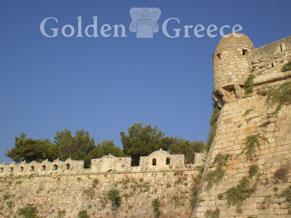
The Venetian fortress of Fortezza is built on the hill of Paleokastro, to the west of the current city. On this hill was the acropolis of the ancient city of Rithymna and the sanctuary of Rokkaia Artemis. The excavations found in various parts of the hill testify to the existence of the acropolis on the rock. The settlement was probably near the port. However, we have no evidence for the form of the settlement, nor for the form of the acropolis and the sanctuary.
In the following centuries, the city of Rethymnon developed on the same spot. Castel Vecchio, the small fortified settlement of the Byzantine era, was preserved until about the middle of the 16th century. In 1540, the construction of a new fortification wall that would also protect the burg, which had spread outside Castel Vecchio, had begun. But the invasion of the Turks in 1571 and the destruction of the city made the need for new fortifications imperative, since the land wall did not cover it. In 1573, Fortezza was founded, on the hill of Paleokastro. The original purpose of the construction was to include all the houses of the city, something that was not done in the end. The inhabitants of the city, after the removal of the Turkish danger, began to rebuild their houses.
The work on the site of Fortezza was completed around 1580. Only the Venetian garrison was installed inside the castle, since the space left for the construction of private houses, after the completion of the public buildings, was ultimately very small. The area on which the castle was built was limited anyway. This had consequences for the general organization of the fortress. The rocky terrain, the absence of a moat and the small area of free space in front of the fortress (spianata), made Fortezza vulnerable defensively. Even the form of the four bastions of the fortress is not complete, as it does not include the necessary elements of a complete bastion. However, some of its weaknesses were covered by the well-thought-out organization of the interior. There were no buildings near the enclosure and the south side, the most exposed to attacks, was protected by bastions (cavalieri). The ammunition depots were on the north side, while the buildings necessary for the siege were arranged on the south.
After 1646 and the occupation of the city by the Turks, Fortezza will not undergo major changes. Additions and additions were made to the embankments and the fort's perimeter. But the number of houses built inside the castle increased. At the beginning of the 20th century the interior of the Fortezza was almost completely built up. Gradually, the transfer of the inhabitants outside the fortress and the demolition of the dilapidated buildings began, by the Municipality of Rethymnon. In the meantime, the Municipality, the Archaeological Service and the EOT expropriated these lands.
Today the fortress of Forteza is the most important monument of Rethymno, a trademark of the city. In its restored buildings it hosts cultural events, exhibitions, while the small Municipal Theater "Erofili" is located on the rampart of Prophet Ilias.
Source: ODYSSEUS - Ministry of Culture & Sports
odysseus.culture.gr